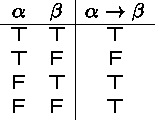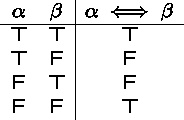Logical Equivalence
If two formulas evaluate to the same truth value in all situations, so that their truth tables are the same, they are said to be logically equivalent.
We write ![]() to indicate that
two formulas
to indicate that
two formulas ![]() and
and ![]() are logically equivalent.
are logically equivalent.
If two formulas are logically equivalent, their syntax may be different, but their semantics is the same. The logical equivalence of two formulas can be established by inspecting the associated truth tables.
Is ![]() logically equivalent to
logically equivalent to ![]() ?
?

Lines 2 and 3 prove that this is not the case.
Substituting logically inequivalent formulas is the source of most real-world reasoning errors.
Is ![]() logically equivalent to
logically equivalent to ![]() ?
?

Yes, ![]() .
.
De Morgan's Laws
There are a number of important equivalences, including the following De Morgan's Laws:
![]()
![]()
These equivalences can be used to transform a formula into a logically equivalent one of a certain syntactic form (called a ``normal form'').
Another useful logical equivalence is double negation:
![]()
Example:
![]()
The first equivalence is by double negation (as equivalence can be used in both directions), the second by De Morgan's Law.
Note that we have just derived a new equivalence,
![]()
which shows that disjunction can be expressed in terms of conjunction and negation!
Some Logical Equivalences
You should be able to convince yourself of (i.e., prove) each of these:
Commutativity of ![]() :
: ![]()
Commutativity of ![]() :
: ![]()
Associativity of ![]() :
: ![]()
Associativity of ![]() :
: ![]()
Idempotence: ![]()
Absorption: ![]()
Distributivity of ![]() :
: ![]()
Distributivity of ![]() :
: ![]()
De Morgan's Law for ![]() :
: ![]()
De Morgan's Law for ![]() :
: ![]()
Double Negation: ![]()
Contradictions: ![]()
Identities: ![]()
Tautologies: ![]()
Tautologies and Contradictions
A tautology is a formula that is always true, no matter which truth values we assign to its variables.
Consider the proposition ``I passed the exam or I did not pass the exam,''
the logical form of which is represented by the formula ![]() .
.

This is a tautology, as we get T in every row of its truth table.
A contradiction is a formula that is always false.
The logical form of the proposition ``I passed the exam and I did not pass the exam''
is represented by ![]() .
.

Tautologies and contradictions are related.
Theorem: If ![]() is a tautology (contradiction)
then
is a tautology (contradiction)
then ![]() is a contradiction (tautology).
is a contradiction (tautology).
Implication
Syntax: If ![]() and
and ![]() are formulas, then
are formulas, then
![]() (read ``
(read `` ![]() implies
implies ![]() '')
is also a formula.
We call
'')
is also a formula.
We call ![]() the premise
and
the premise
and ![]() the conclusion
of the implication.
the conclusion
of the implication.
Semantics: If ![]() is true and
is true and ![]() is false, then
is false, then
![]() is false. In all other cases,
is false. In all other cases, ![]() is true.
is true.
Truth table:

Example:
The semantics of implication is trickier than for the other connectives.
Implication can also be expressed by other connectives,
for example,
![]() is logically equivalent to
is logically equivalent to
![]() .
.
Prosecutor: ``If the defendant is guilty, then he had an accomplice.''
Defense Attorney: ``That's not true!!''
What did the defense attorney just claim??
Biconditional
Syntax: If ![]() and
and ![]() are formulas, then
are formulas, then
![]() (read ``
(read `` ![]() if and only if (iff)
if and only if (iff) ![]() '')
is also a formula.
'')
is also a formula.
Semantics: If ![]() and
and ![]() are either both true or both false, then
are either both true or both false, then
![]() is true. Otherwise,
is true. Otherwise, ![]() is false.
is false.
Truth table:

Example:
The biconditional may be viewed as a shorthand for a conjunction of two implications, as
![]() is logically equivalent to
is logically equivalent to
![]() .
.
Necessary and Sufficient Conditions
The phrase ``necessary and sufficient conditions'' appears often in mathematics.
A proposition ![]() is necessary for
is necessary for ![]() if
if ![]() cannot be true
without it:
cannot be true
without it: ![]() is a tautology.
is a tautology.
Example: It is necessary for a student to have a 2.8 GPA in the core courses to be admitted to become a CSE major.
A proposition ![]() is sufficient for
is sufficient for ![]() if
if ![]() is a tautology.
is a tautology.
Example: It is sufficient for a student to get A's in CSE 113, CSE 114, CSE 213, CSE 214, and CSE 220 in order to be admitted to become a CSE major.
Theorem
If a propositionis both necessary and sufficient for
, then
and
are logically equivalent (and vice versa).
Tautologies and Logical Equivalence
Theorem: A propositional formula ![]() is logically equivalent to
is logically equivalent to ![]() if and only if
if and only if
![]() is a tautology.
is a tautology.
Proof:
(a)
If ![]() is a tautology, then
is a tautology, then ![]() is logically
equivalent to
is logically
equivalent to ![]() .
.
Why?
If ![]() is a tautology,
then it is true for all truth assignments.
By the semantics of the biconditional,
this means that
is a tautology,
then it is true for all truth assignments.
By the semantics of the biconditional,
this means that ![]() and
and ![]() agree on every row
of the truth table. Hence the two formulas are logically equivalent.
agree on every row
of the truth table. Hence the two formulas are logically equivalent.
(b)
If ![]() is logically equivalent to
is logically equivalent to ![]() , then
, then
![]() is a tautology.
is a tautology.
Why?
If ![]() and
and ![]() are logically equivalent,
then they evaluate to the same truth value
for each truth assignment.
By the semantics of the biconditional,
the formula
are logically equivalent,
then they evaluate to the same truth value
for each truth assignment.
By the semantics of the biconditional,
the formula ![]() is true in all situations.
height6pt width4pt
is true in all situations.
height6pt width4pt
Related Implications
Implication: ![]() : If you get A's on all exams, you get an A in the course.
: If you get A's on all exams, you get an A in the course.
Converse: ![]() .
If you get an A in the course, then you got A's on all exams.
.
If you get an A in the course, then you got A's on all exams.
Inverse: ![]() .
If you didn't get A's on all exams, then you didn't get an A in the course.
.
If you didn't get A's on all exams, then you didn't get an A in the course.
Contrapositive: ![]() .
If you didn't get an A in the course, then you didn't get A's on all exams.
.
If you didn't get an A in the course, then you didn't get A's on all exams.

Note that implication is logically equivalent to the contrapositive, and that the inverse is logically equivalent to the converse!
Deriving Logical Equivalences
We can establish logical equivalence either symbolically or via truth tables.
Example: ![]() is logically
equivalent to
is logically
equivalent to ![]() .
.

Symbolic proofs are much like the simplifications you did in high school algebra - trial-and-error leads to experience and finally cunning.
Example: ![]()
Proof: (which laws are used at each step?)
